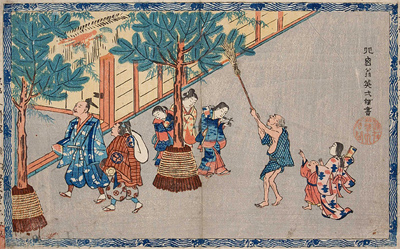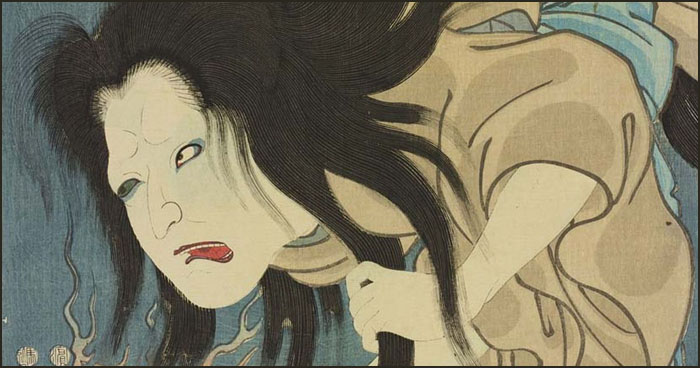[ . BACK to DARUMA MUSEUM TOP . ]
. Famous Places and Powerspots of Edo 江戸の名所 .
::::::::::::::::::::::::::::::
Takanawa district 高輪, Takanawadai 高輪台

Takanawa Uchimachi 高輪牛町 Takanawa Ushicho
. machiwari, machi-wari 町割り 'division of towns and streets', districts .
Each machi 町 square was closed by a kido 木戸 wooden gate. The gates were open from 4 in the morning till about 10 in the evening.
高縄 "High rope", Takanawa is the original spelling of the name, 高縄手道 Takanawa Temichi.
The straight road looks like a rope spread out on the high ground (takadai 高台) and was the first view of visitors entering the town of Edo via the Tokaido road.
The district is divided in three parts, 高輪北町 North, 高輪中町 Central, and 高輪南町 South, which was close to Shinagawa.
Next to the Northern Takanawa district was 高輪車町 Takanawa Kurumacho with the Great Gate.
The sea front along Central Takanawa was called 袖ヶ浦 Sodegaura. It was connected to the river 深川 Fukagawa
via a canal.
..............................
高輪之明月 Full Moon at Takanawa

Hiroshige 歌川広重
..............................
高輪二十六夜 Takanawa on the night of the 26th day

Utagawa Toyokuni III and Utagawa Hiroshige II 1864
Takanawa was famous for its full view of Edo Bay, especially for viewing the Nijūrokuyamachi moon.
"Nijūrokuyamachi" was a custom where people would wait for the late moon rising on the 26th day of the first and seventh month of the lunar calendar and many would gather on coasts and heights.
- source : library.metro.tokyo.jp/Portals -
..............................
「江戸十二景 高輪」Takanawa - from the series Twelve Views of Edo

Utagawa Hiroshige I
source : mfa.org/collections/object Boston
..............................
Takanawa Ushimachi 高輪牛町 Takanawa "Ox Town"
- quote -
Oxen were used for overland transport of heavy cargo in Edo.
Ox carts came into use around 1630, and at one point Edo had 30 ox keepers with a total of 600 oxen, but this mode of transport declined as human-pulled daihachiguruma carts came into widespread use.
- source :web-japan.org/tokyo/know - Edo Transportation -

source : yogimessage.seesaa.net/article - Hasegawa Settan
- quote
Takanawa Okido 高輪 大木戸 The Gates of Edo - Takanawa
Edo is a huge, sprawling city with over one million inhabitants. When Tokugawa Ieyasu first started building the city, he could never have imagined that it would grow to such a size. Today, the suburbs of the city are expanding farther and farther, so that when many people speak of "Edo", they are talking about the towns and villages that stretch as far as the Tama river to the southwest and the Ara river to the north and east. However, there is a landmark on the Tokaido, on the southern edge of the city, which has long been considered the "official" gateway to the city. A broad, imposing stone wall, which crosses the main road, extends all the way to the shore of Edo bay, and the Tokaido passes through this wall at a huge gate, known as the Takanawa Okido (great wooden gate).
Today, the Okido at Takanawa, and a similar gate at Yotsuya, are little more than official boundary markers. However, when they were first built, these massive gates formed the first line in the military defenses that the Shoguns built to protect their capital. The Takanawa district also marks the start of the shitamachi, or "downtown" area of Edo, characterized by its tightly packed "row houses", stores, workshops and official buildings. Traditionally, the Okido is also the place where relatives and friends say their farewells to people travelling west from Edo.

The great gate and stone wall were originally built as defences to protect the city from attack. No one has ever attempted to attack Edo, and probably no one would ever dream of doing so today. In the late 1700s, Japan has enjoyed a period of peace and stability for well over 150 years! However, when Tokugawa Ieyasu, the first Shogun, began building his capital city here in 1590, the country was still in the final phases of a long era of almost continuous warfare, and Ieyasu spared no expense to build strong fortifications for his city.
The long period of civil war and internal strife was called the Sengoku Jidai (The age of warring states). It was an age of countless battles and skirmishes between powerful daimyo, and it lasted for more than a century. During this period, no part of the country could consider itself totally safe from attack, so all of the major daimyo built huge fortresses to protect their domains. Although Edo has now grown into a sprawling, peaceful metropolis, you can still see the remains of when it was a fortress city, controlled by the most powerful warlord in Japan. Massive ramparts, moats, and towering fortress walls can be seen almost everywhere you go in the city
Just outside the gate, in a wide and busy square, are many chaya (tea houses). The people of Edo eat many of their meals at tea shops or other "restaurants", rather than at home. This is partly because their houses tend to be quite small and cooking space is at a premium. Besides, it is almost as expensive to eat at home as it is to eat out, and it is definitely more work to cook. In the warm and humid climate that characterizes Edo for most of the year, food spoils quickly. Apart from pickled vegetables or dried basic foods like rice and noodles, it is difficult to store food items at home. Therefore, even when they make a home-cooked meal Edo citizens have to buy most of their food on the same day they eat it.
Because it is so difficult and time-consuming to eat at home, people in Edo (especially those from the middle and upper classes) have developed the habit of "eating out" often. Nearly every district of the city has clusters of chaya. Small restaurants and food stalls can be found on most main streets. There is a wide variety of different types of chaya in Edo. Some serve only tea, and often treat customers to a simplified version of the traditional Japanese tea ceremony. Others are more like restaurants, serving all sorts of food and snacks. Some chaya offer entertainment, such as singers, comedians or even amateur sumo wrestling.
The tea houses in the Okido district are all quite busy throughout the day, but interesting enough, the biggest crowds can be seen in the early morning. This is because large groups of people come to Takanawa to see off relatives or friends who are preparing to embark on journeys along the Tokaido. Takanawa Okido has traditionally been the spot where people say their farewells. In order to get a good start on the journey, most travellers leave early in the morning. That is why the shops and restaurants around the Okido are quite busy in the morning
Highway travel is extremely common in Edo Japan, perhaps more so than in any other nation of the world during the same period. The strong tradition of religions pilgrimages accounts for many of the travelers. In addition, merchants and entertainers are a common sight on the highways. However, the majority of the traffic up and down Japan's major roads is the result of the system of Sankin-kotai (alternate attendance) -- a custom that forces all of the major daimyo to spend at least four months out of every year living in Edo.
The first Shoguns instituted the custom of Sankin-kotai in order to keep an eye on their main military rivals. Japan was just emerging from the Sengoku Jidai, and the leaders were never sure how much they could trust their vassals. Tokugawa Ieyasu passed a law which forced major daimyo to build homes in Edo and to spend a part of every year living in Edo. This gives the Shogun a chance to keep an eye on them, and test their loyalty. For the other eight months of the year, they are allowed to go back to their homes in the provinces to look after their land and take care of local business. However, their wives and their eldest sons have to remain in Edo whenever they return home. If any daimyo decided to rebel against the Shogun, their wives and children could be used as hostages.
Thus, every daimyo in Japan makes an elaborate journey twice a year (one trip going to Edo and another going back to their home province). During the journey, the daimyo is accompanied by dozens, if not hundreds of assistants, retainers and family members. There is also a steady stream of lesser officials, who also travel with fairly large groups of servants and guards. These officials and advisors carry messages and information to and from the daimyo, allowing them to govern their provinces effectively even while they are in Edo.
- source : Edomatsu
. chaya, -jaya 茶屋 tea shop, tea stall - Introduction .
. sankin kootai 参勤交代 Sankin Kotai Daimyo attendance in Edo .

Takanawa Ushimachi 高輪うしまち / Hiroshige 歌川広重
::::::::::::::::::::::::::::::
. 47浪人 / 忠臣蔵 47 Ronin and the Chushingura and Sengaku-Ji 泉岳寺 .
"In the midst of a nest of venerable trees in Takanawa, a suburb of Yedo, is hidden Sengakuji, or the Spring-hill Temple, renowned throughout the length and breadth of the land for its cemetery, which contains the graves of the Forty-seven Rônin, famous in Japanese history, heroes of Japanese drama, the tale of whose deed I am about to transcribe."
— Mitford, A. B.
..............................
. Gofunai 御府内八十八ヶ所霊場 88 Henro Temples in Edo .
高野山東京別院 Koyasan Tokyo Betsu-In - "Koyasan Tokyo Branch Temple"
港区高輪3-15-18 // Minato Ward, Takanawa
. 高輪銭洗不動 Takanawa Zeniarai Fudo. .
Fudo Temple to wash your money to make it multiply.
東京都港区高輪一丁目 - 黄梅院 Kobai-In
..............................
Toozenji, Tōzen-ji 東禅寺 Tōzen-ji
- quote -
a Rinzai Zen temple established in 1609.
The first British legation in Japan was placed in this temple in 1859, but it was assaulted twice soon after that by samurais who were opposed to its existence, which resulted in some dead or wounded, and the legation retreated to Yokohama following this event.
Its precincts are well-maintained, and there is a three-storied-pagoda.
Sanmon, the main gate of the temple, was erected in 1971.
Hondo was completed in 1933.
Sanju-no-to, or the three-story pagoda, was erected in 1992.
- source and photos : visiting-japan.com/en -
..............................
- More Takanawa sites -
Shrine Maruyama Jinja / Hatakeyama Memorial Museum
::::::::::::::::::::::::::::::
- - - - - H A I K U and S E N R Y U - - - - -
石蕗咲くや高輪木戸に馬の墓
tsuwa saku ya Takanawa kido ni uma no haka
rock butterburs are flowering -
graves of the horses
at Takanawa Great Gate
Tr. Gabi Greve
Itoo Hideji 伊東秀二 Ito Hideji
. WKD : tsuwa no hana 石蕗の花 rock butterbur flowers .
- - kigo for early winter - -
::::::::::::::::::::::::::::::

- - - To join me on facebook, click the image !
::::::::::::::::::::::::::::::
. Famous Places and Powerspots of Edo 江戸の名所 .
. Doing Business in Edo - 商売 - Introduction .
. shokunin 職人 craftsman, craftsmen, artisan, Handwerker .
. Japanese Architecture - Interior Design - The Japanese Home .
. senryu, senryū 川柳 Senryu poems in Edo .
. densetsu 伝説 Japanese Legends - Introduction .
[ . BACK to DARUMA MUSEUM TOP . ]
[ . BACK to WORLDKIGO . TOP . ]- - - - - #takanawa #takanawaokido - - - -
::::::::::::::::::::::::::::::
--
Posted By Gabi Greve to Edo - the EDOPEDIA - on 10/20/2015 09:31:00 am









































